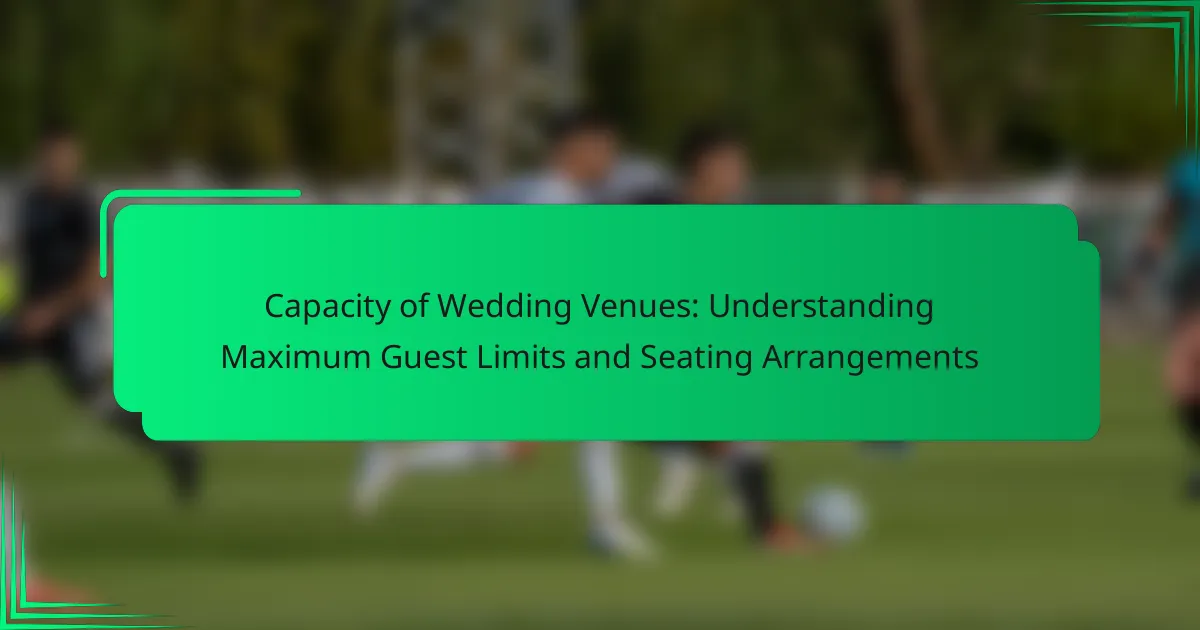The article focuses on the capacity of wedding venues, which varies significantly based on their size and layout. Smaller venues typically accommodate 50 to 100 guests, while medium-sized venues can host 100 to 300 guests, and large venues often cater to over 300 guests, with some capable of accommodating up to 1,000. Factors influencing venue capacity include seating arrangements, local regulations, and safety compliance, such as fire codes and accessibility requirements under the Americans with Disabilities Act (ADA). Couples are advised to determine their guest list size and consider the maximum capacity of potential venues, taking into account seating preferences and necessary space for pathways and activities. Understanding these elements is essential for ensuring guest comfort and legal compliance during wedding planning.

What is the Capacity of Wedding Venues?
The capacity of wedding venues varies widely based on their size and layout. Smaller venues may accommodate 50 to 100 guests. Medium-sized venues typically host 100 to 300 guests. Large venues can often accommodate over 300 guests, with some capable of hosting up to 1,000 or more. The specific capacity is influenced by factors such as seating arrangements, available space, and local regulations. For example, banquet-style seating may reduce overall capacity compared to theater-style arrangements. Accurate capacity information is crucial for planning and ensuring guest comfort.
How is the maximum guest limit determined for wedding venues?
The maximum guest limit for wedding venues is determined by several factors. These include the venue’s size, layout, and local regulations. Fire codes typically dictate safety capacity limits. Venues also consider seating arrangements and accessibility. Additionally, the type of event can influence the limit. For example, a standing reception may allow more guests than a seated dinner. Venue management often conducts assessments to finalize the guest capacity. This ensures both safety and comfort for attendees.
What factors influence the maximum guest capacity?
The maximum guest capacity of a venue is influenced by several factors. The size of the venue is a primary determinant. Larger spaces can accommodate more guests. Layout and design also play a significant role. Open floor plans allow for more flexible seating arrangements. Fire safety regulations impose limits on occupancy. These regulations ensure the safety of all guests in case of emergencies. Furniture arrangement affects capacity as well. The type and arrangement of tables and chairs can either maximize or minimize space. Additionally, local laws and venue policies dictate maximum limits. These rules are established to comply with safety and operational standards.
How do venue layouts impact guest limits?
Venue layouts significantly impact guest limits by determining the available space for seating and movement. Different layouts, such as theater, banquet, or classroom styles, allocate space differently. For example, a theater layout maximizes seating capacity by using rows of chairs, while a banquet layout requires more space for tables. Fire codes and safety regulations also dictate maximum occupancy based on layout. Additionally, the arrangement of exits influences how many guests can safely occupy the venue. According to the National Fire Protection Association, occupancy limits are calculated based on square footage and layout configurations. Therefore, the choice of layout directly affects how many guests can be accommodated safely and comfortably.
Why is understanding seating arrangements important for wedding planning?
Understanding seating arrangements is crucial for wedding planning because they directly influence guest experience and venue capacity. Proper seating enhances social interactions and ensures that guests feel comfortable. It also helps in managing the flow of the event, allowing for smooth transitions between different phases like the ceremony and reception. Additionally, effective seating arrangements can accommodate specific needs, such as accessibility for elderly or disabled guests. Research shows that well-planned seating can reduce stress and enhance enjoyment during events. This is supported by studies indicating that thoughtful seating can improve overall guest satisfaction by up to 30%.
What are the common types of seating arrangements for weddings?
Common types of seating arrangements for weddings include the traditional banquet style, theater style, and U-shape. Banquet style features round tables seating eight to ten guests each. This arrangement promotes conversation and intimacy among guests. Theater style uses rows of chairs facing the front, ideal for ceremonies. U-shape seating encourages interaction among guests while allowing a view of the couple. Other arrangements include classroom style, which is similar to theater but with tables, and family style, where food is served on shared platters. Each arrangement serves different purposes, accommodating various guest counts and preferences.
How do different seating styles affect guest interaction?
Different seating styles significantly influence guest interaction. For instance, round tables promote conversation by allowing guests to face each other easily. This arrangement encourages larger group discussions and fosters a sense of community. In contrast, long banquet tables can create a more formal atmosphere. Guests may find it harder to engage with those seated farther away. Additionally, lounge seating can enhance comfort and relaxation. This style often leads to more intimate conversations. According to a study by the Journal of Hospitality and Tourism Research, seating arrangements directly impact social dynamics at events. The findings indicate that layout affects both the quality and quantity of interactions among guests.

What are the legal considerations regarding venue capacity?
Legal considerations regarding venue capacity include compliance with local fire codes and safety regulations. These laws dictate the maximum number of occupants allowed in a venue. Exceeding this limit can result in fines or legal action. Venues must also consider accessibility requirements under the Americans with Disabilities Act (ADA). This ensures that all guests can safely enter and exit the venue. Additionally, insurance policies may require adherence to capacity limits. This protects against liability in case of accidents. Local zoning laws may further influence capacity regulations. These laws vary by location and can affect the operational aspects of a venue.
How do local regulations affect maximum guest limits?
Local regulations set specific maximum guest limits for venues. These regulations often include safety codes, occupancy permits, and zoning laws. Compliance with fire safety codes typically dictates the number of guests based on available exits and floor space. Zoning laws may restrict venue capacity based on the location and intended use of the property. Additionally, local health regulations can influence guest limits, especially during events involving food service. For example, the National Fire Protection Association (NFPA) recommends calculating occupancy based on square footage to ensure safety. Thus, local regulations play a crucial role in determining the maximum number of guests allowed at a venue.
What permits or licenses are required for larger gatherings?
Larger gatherings typically require permits or licenses such as a special event permit, noise permit, and possibly a liquor license. A special event permit is often needed for gatherings that exceed a certain number of attendees, which varies by location. A noise permit may be necessary if the event will involve amplified music or sound. If alcohol is served, a liquor license is usually required to comply with local regulations. These permits ensure that the event adheres to safety, zoning, and legal standards. Local government offices often provide specific guidelines and application processes for obtaining these permits.
How can venues ensure compliance with safety regulations?
Venues can ensure compliance with safety regulations by conducting regular inspections and audits. These inspections should evaluate fire safety measures, emergency exits, and crowd control protocols. Staff training is essential for understanding safety procedures and emergency response. Venues must also stay updated on local regulations and industry standards. Implementing a clear safety plan can help manage risks effectively. Additionally, maintaining accurate records of safety equipment and inspections reinforces compliance. Engaging with local authorities can provide valuable guidance on regulatory requirements. Regularly updating safety protocols based on feedback and incidents further enhances compliance.
What are the implications of exceeding venue capacity?
Exceeding venue capacity can lead to serious legal and safety implications. Venues are required to adhere to fire codes and safety regulations. These regulations specify maximum occupancy limits to ensure safe evacuation during emergencies. If a venue exceeds this limit, it can face fines and legal action from local authorities. Additionally, overcrowding can create hazardous conditions, increasing the risk of accidents and injuries. Event organizers may also experience liability issues if guests are harmed due to unsafe conditions. Furthermore, exceeding capacity can negatively impact the guest experience, leading to discomfort and dissatisfaction.
What risks are associated with overcrowding at events?
Overcrowding at events poses several significant risks. One major risk is increased likelihood of accidents. When too many people are present, movement becomes restricted. This can lead to trampling or injuries during emergencies. Another risk is compromised safety measures. Emergency exits may become blocked or difficult to access. Additionally, overcrowding can strain resources, such as restrooms and food services. This often results in unsatisfactory experiences for attendees. Crowd control becomes challenging, raising tensions among guests. Historical data shows that overcrowding has contributed to several tragic incidents at events. For instance, the 1979 Hillsborough disaster resulted from overcrowding, leading to 96 fatalities.
How can planners avoid penalties for exceeding limits?
Planners can avoid penalties for exceeding limits by adhering strictly to venue capacity guidelines. This involves understanding the maximum guest limits set by the venue. Compliance with these limits ensures that planners do not incur fines or face legal repercussions. Regular communication with venue management is essential for clarifying any uncertainties about capacity. Additionally, planners should maintain accurate guest lists and RSVP counts. They can implement a system for tracking guest confirmations to avoid last-minute additions. Familiarity with local regulations regarding occupancy limits also helps in preventing violations. By following these practices, planners can effectively manage guest numbers and avoid penalties.

How can couples choose the right venue based on capacity?
Couples can choose the right venue based on capacity by first determining their guest list size. They should consider the maximum capacity of potential venues. Each venue typically provides its maximum occupancy limit. Couples should also account for seating arrangements and layout preferences. For example, round tables require more space than rectangular ones. It’s essential to leave room for pathways and dance floors. Couples can ask venue managers for recommendations on optimal capacity. This ensures comfort and enjoyment for all guests.
What questions should couples ask when assessing venue capacity?
What questions couples should ask when assessing venue capacity include: What is the maximum capacity of the venue? Couples need to know the number of guests the venue can accommodate. Is the capacity based on seated or standing arrangements? This distinction affects how many people can fit comfortably. Are there any restrictions on layout or seating arrangements? Understanding layout limitations is crucial for planning. What is the fire code capacity? This legal limit ensures safety during the event. Are there additional fees for exceeding the capacity? Couples should be aware of potential extra costs. How does the venue handle space for vendors? This can impact the overall flow of the event. What is the minimum capacity required to book the venue? This helps in planning guest lists effectively. Lastly, is there flexibility in the capacity for future adjustments? Knowing this allows for potential changes in guest count.
How can couples visualize their seating arrangements before booking?
Couples can visualize their seating arrangements before booking by using seating chart software or apps. These tools allow users to create digital layouts of their venue. Couples can drag and drop tables and chairs to see how their guests will be arranged. Many platforms also offer templates specific to wedding venues. This helps in understanding space utilization and guest interactions. Some venues provide 3D models or floor plans for better visualization. Couples can also consult with wedding planners for expert advice. Using these methods ensures an effective seating plan that meets their needs.
What are the best practices for managing guest lists and seating?
The best practices for managing guest lists and seating include creating a detailed guest list early. This facilitates accurate headcounts and ensures all important individuals are invited. Use digital tools or spreadsheets for easy updates and tracking. Organize guests into categories, such as family, friends, and colleagues, to simplify seating arrangements.
Consider venue layout when planning seating. This helps optimize space and enhances guest interaction. Assign seats or tables to avoid confusion on the event day. Communicate seating arrangements clearly through place cards or a seating chart.
Regularly update the guest list to account for RSVPs. This ensures accurate seating and meal counts. Lastly, remain flexible to accommodate last-minute changes. This adaptability can improve the overall guest experience.
How can couples effectively prioritize their guest list?
Couples can effectively prioritize their guest list by categorizing invitees into essential groups. Start by listing immediate family and closest friends. This ensures that key individuals are included first. Next, consider extended family and friends who have significant relationships with the couple. Assess the venue’s capacity to determine how many guests can be accommodated. Couples should also discuss their budget, as this can limit the number of guests. Prioritizing based on relationships and significance helps streamline the list. Finally, be prepared to make tough decisions if the list exceeds capacity. This method ensures that the most important people are present on the special day.
What tools can assist in planning seating arrangements?
Seating arrangement planning can be effectively assisted by various tools. Event planning software, like Social Tables, allows users to create floor plans and visualize seating layouts. Online platforms such as AllSeated provide 3D visualization features for more immersive planning. Spreadsheet applications like Microsoft Excel can help organize guest lists and seating preferences. Additionally, mobile apps like Guest List Organizer streamline guest management and seating assignments. These tools enhance organization and efficiency during the seating arrangement process.
The main entity of this article is the capacity of wedding venues, focusing on understanding maximum guest limits and seating arrangements. The article explores how venue size, layout, and local regulations influence capacity, emphasizing the importance of accurate capacity information for guest comfort and safety. It details the various factors affecting maximum guest limits, including legal considerations and the impact of seating arrangements on guest interaction. Additionally, the article provides practical insights for couples on selecting the right venue based on capacity and managing their guest lists effectively.
